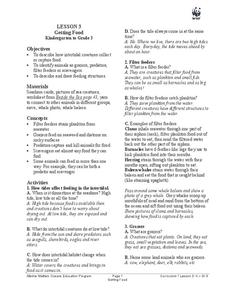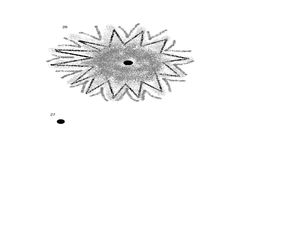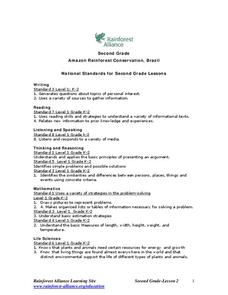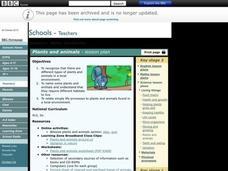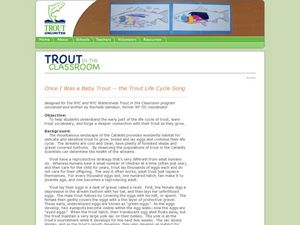Curated OER
Diversity of Life
Students identify the difference between eukaryote and prokaryotes and examine the structure of bacteria. In this bacteria lesson students examine the different ways that bacteria are classified through an activity.
Curated OER
Museums in the Classroom Pumpkin Project
Students identify the 5 stages in the life cycle of a pumpkin. They create a model showing the correct order of pumpkin life stages. They explain a pumpkin's life cycle to a partner, using their model.
Curated OER
Ladybugs
Third graders keep and report records of investigations and observations of ladybugs utilizing tools like journals, charts, graphs and computers. They discover and study the life cycle of ladybugs and complete a KWL chart about ladybugs.
Curated OER
Start at the Very Beginning
Students explore ocean ecosystems. In this cross curriculum art and oceans lesson plan, students create a collage featuring three-finger algae using sand paper, tissue paper, and construction paper.
Curated OER
How Does Your Garden Grow?
Students construct and maintain a school garden. In this gardening instructional activity, students plan the construction of the garden by writing letters to local businesses asking for supplies and materials; students build the garden...
Curated OER
Salmon Homing Instincts
Students identify the stages of the salmon life cycle. In this fish lesson, students experience first hand what it would be like to be a returning salmon attempting to identify a home stream by smell.
Curated OER
2.0 "Water Is Life" Global Water Awareness Mini-Unit (Grades3-5)
Students study the amount of potable water on the Earth. In this water lesson, students examine the amount of potable water as compared to all the water on the Earth. They discuss why many parts of the world do not have access to good...
Curated OER
Araceli Solis Butterflies Unit
Third graders study the life cycle, eating habits, habitats, and migration patterns of butterflies in this series of lessons.
Curated OER
Getting Food
Learners complete activities to learn about the ocean food web. In this ocean life lesson, students discuss how the tides affect feeding, learn about filter feeders, grazers, predators, and scavengers. Learners then group the animals...
Curated OER
The Human Body Lesson
Students identify features of the human body, explore needs of the human body by explaining the importance of good health in relationship to the body, and study functions and care of the human body and its organs.
Curated OER
TE Lesson: Out of Breath
Students study the parts of the human respiratory system while examining the gas exchange that takes place in the lungs. They make a model lung. They look at how the respiratory system is affected by spaceflight.
Aquarium of the Pacific
Turn a Cow into a Whale
Third graders explore animals that might have a common ancestor and resemble one another. For this cow and whale lesson plan, 3rd graders recognize the similarities between the whale and the cow. Students complete worksheets...
Curated OER
Turbidity Experiment
Students experiment with turbidity in water. In this turbidity lesson, students get a glass of water and shine a light through it to see how the light reflects. They slowly add dirt and shine the light to show how the dirt affects it...
Curated OER
Monarch Egg
Students investigate the stages of the Monarch butterfly and its life cycle. In this butterfly life cycle lesson, students discuss when, where, and how the Monarch butterflies lay their eggs. After discussion, students...
Curated OER
A Peek into the Lives of Stars!
Students create a model of the birth of a star and demonstrate the stages of the star's lifecycle. In this star lifecycle instructional activity, students mix flour and water in a jar to model the birth of a star, then role-play...
Curated OER
Food Webs
Young scholars research an animal to define its food web and life cycle. In this animal life cycle lesson, students research an animal and define its food web. Young scholars then present their animal food webs to the class and note...
Curated OER
Seed Structure and Seed Dispersal
Third graders plant seeds. In this seed structure lesson, 3rd graders identify parts of a seed and plant a lima bean seed. Students discuss and reflect on the process in their journals.
Curated OER
Amazon Rainforest Conservation, Brazil
Students explore the concept of understanding the effects of disturbances in an environment. In this life science lesson, students use the game Jenga to help capture the idea of environment disturbances. Students discuss the...
Curated OER
Underwater Animals
Students investigate mammals and blubber. In this science lesson plan abut the sea, students perform an experiment that will help them in discovering how blubber keeps sea mammals warm.
Curated OER
Seed Diversity
Students explore agriculture by researching different seeds. In this seed identification lesson, students collaborate in small groups to analyze a package of different seeds. Students utilize a magnifying glass to examine each seed...
Curated OER
Plants and Animals
Students discuss the different types of plants and animals in a local environment. In this science lesson, students name some plants and animals understanding that they require different habitats to live. Students use computers to...
Curated OER
The Water Cycle
Students identify the various ways water move throughout the earth as part of the water cycle. In this science lesson, students gain a knowledge of basic science concepts related to everyday life through patterns and how they repeat as...
Curated OER
Once I Was a Baby Trout
Learners sing a song about the trout life cycle. In this trout life cycle lesson plan, students learn trout vocabulary and make motions while singing this song.
Curated OER
Germs Can Make You Sick
Students explore how germs are spread. In this science lesson, students practice good hand washing practices and discuss how washing hands can prevent the spread of germs.








